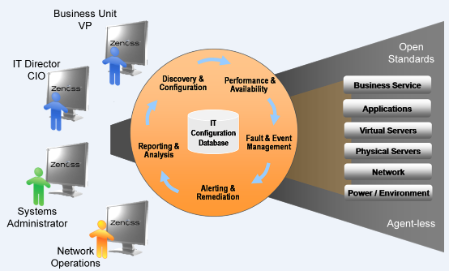The Zenoss system provides full stack coverage of networks, servers, applications, services, and virtualization. Functionally, it provides complete operational awareness by combining discover and inventory, availability and performance monitoring, event management, and reporting.
At its highest level, the system comprises these major areas:
Discovery and configuration
Performance and availability
Fault and event management
Alerting and remediation
Reporting
Zenoss unifies these areas into a single system with a modern, interactive Web user interface.
Zenoss was designed with these important ideas at its core:
Modeling
The system's model enables it to understand the environment in which it operates. Through sophisticated and detailed analysis, Zenoss determines how to monitor and manage complex IT environments. The core of the standard model describes basic information about each device's operating system and hardware. The model is object-based, and is easily extended through object inheritance.
Discovery
With a sophisticated model, manual input and maintenance of data is challenging. To address this challenge, Zenoss uses discovery to populate the model. During discovery, the system accesses each monitored device in your infrastructure and interrogates it in detail, acquiring information about its components, network integration, and dependencies.
Normalization
Because Zenoss collects information from different platforms and through different protocols, the amount and format of available information varies. For example, file system information gathered from a Linux server differs from similar information gathered from a Windows server. Zenoss standardizes the data gathered so that you can perform valid comparisons of metrics gathered by different methods and for different systems.
Agentless Data Collection
To gather information, Zenoss relies on agent-less data collection. By communicating with a device through one of several protocols (including SNMP, SSH, Telnet, and WMI), it minimizes the impact on monitored systems.
Full IT Infrastructure
Unlike other tools, the system's inclusive approach unifies all areas of the IT infrastructure--network, servers, and applications--to eliminate your need to access multiple tools.
Configuration Inheritance
Zenoss extends the concept of inheritance in object-oriented languages to configuration. All core configuration parameters (configuration properties) and monitoring directions (monitoring templates) use inheritance to describe how a device should be monitored. Inheritance allows you to describe, at a high level, how devices should be monitored. It also supports ongoing refinements to the configuration. (For detailed information on inheritance and templates, refer to the chapter titled "Properties and Templates.")
Cross-Platform Monitoring
Zenoss monitors the performance and availability of heterogeneous operating systems (including Windows, Linux, and Unix), SNMP-enabled network devices (such as Cisco), and a variety of software applications (such as WebLogic and VMware).
Scale
You can deploy the system on a single server to manage hundreds of devices. The Enterprise version allows you to manage large, distributed systems by using horizontal scaling of its collectors.
Extensibility
The system's extension mechanism, ZenPacks, allow for rapid addition and modification to customize your environment.





